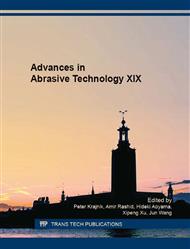p.151
p.158
p.167
p.172
p.178
p.187
p.193
p.199
p.205
Estimation of Unsteady and Steady Polishing Force in Magnetic Abrasive Finishing Using a Permanent Magnet End-Mill Tool
Abstract:
Stable finishing is considered difficult to achieve using conventional magnetic abrasive because of its unstable polishing characteristics. In this paper, three different shapes of iron particles are used to produce a magnetic brush to improve stability. The unsteady and steady polishing force produced under the magnetic field of an end-mill type tool is discussed. We also develop prototype equipment combining a high speed camera with a force sensor to analyse micro-changes in the magnetic brush while machining. The relationship between the unsteady or steady polishing force and the polishing capability of the magnetic brush is explored in an attempt to construct a model for predicting polishing forces.
Info:
Periodical:
Pages:
178-183
Citation:
Online since:
October 2016
Authors:
Keywords:
Price:
Сopyright:
© 2016 Trans Tech Publications Ltd. All Rights Reserved
Share:
Citation:


